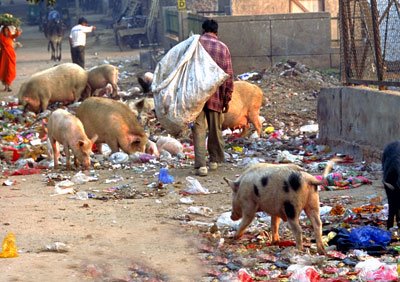
The Guardian has an illuminating article on a disturbing new travel experience that gives visitors a glimpse into the lives of Delhi's street children.
Some excerpts:
Clearing his throat theatrically as he gets ready to reveal a highlight of the tour, group leader Javed stops halfway up the staircase to platform one and points through the railings to a dark alcove beneath the footbridge over the tracks.
'This is where the street children sleep,' he says, smiling at the cluster of tourists who are craning forward to hear his voice above the roar of the trains below. A small boy climbs out from the hole, steps across the corrugated iron roof and balances himself on a ledge on the other side of the bars, staring back at the visitors, perplexed.
The tourists pause for a while taking in his malnourished appearance, his filthy clothes and glazed eyes. The boy doesn't say anything, but Javed briskly explains that this child, like a lot of the homeless children who live in New Delhi railway station, is addicted to a white correction fluid, called Eraz-Ex.
Most carry a small square of cloth soaked in the chemical, which they hold to their noses and inhale periodically. 'They spend more than half the money they earn from selling rubbish they find on the platform on buying it from the stationary stalls in the market,' he says. 'It does make them a bit violent.'
He pauses to give the group of visitors from Australia, Russia and England a chance to ask questions, before running through the advantages of sleeping in the gap between the platform roof and the walkway. It's shady and you have to be small to get to it, which makes it relatively safe from the station police. But there are the overhead electricity wires to look out for. 'Several of the children have been electrocuted by that wire,' he adds.
The tour moves swiftly on to a secluded train siding, where around 15 children are sitting on a carpet, each with a small blackboard, helped by a volunteer to write a few letters and numbers. These are children who live with their families in the tents and shacks around the station. Their parents have brought them to the capital to escape desperate rural poverty. Protected by their relatives from the harshest violence of street life, these children are better off than the orphans who sleep on the station roof, but life remains a battle against hunger.
Javed explains how each platform is controlled by a gang leader, one of the older street children, who protects and menaces the other boys in his care. Shouting to make himself heard above the rumbling of the trains, our guide explains that children who run away from home - escaping alcoholism, poverty, natural disasters and family violence - usually take the train to Delhi. Gang leaders spot a new arrival as soon as he steps off the train and offer help with finding food and safe places to sleep.
New arrivals are shown how to strap sharp blades to their index fingers for slashing pockets; they learn which fruit-juice sellers will protect them and where to sell the plastic bottles and silver foil picked from the carriage. Their day's takings are taken by the gang leader who redistributes the money (although not all of it) on Saturday, when the children take a day off to watch Bollywood movies. Platform one, where the luxury tourist trains stop, is the most heavily policed area, but also the most lucrative fiefdom, and street children are skilled at dodging trains to crawl into the carriages from the other side. There are no girls in the gangs because they are picked up by pimps as soon as they arrive, Javed explains.
By the end of the walk, the group is beginning to feel overwhelmed by the smells of hot tar, urine and train oil. Have they found it interesting, Javed asks? One person admits to feeling a little disappointed that they weren't able to see more children in action - picking up bottles, moving around in gangs. 'It's not like we want to peer at them in the zoo, like animals, but the point of the tour is to experience their lives,' she says. Javed says he will take the suggestion on board for future tours.
Babloo, who thinks he is 10, has been living here for maybe three years. His hands are splashed white from the correction fluid that he's breathing in through his clenched left fist, and he pulls a dirty bag filled with bottles with his other hand. His life is unrelentingly bleak and he recognises this. 'I don't know why people come and look at us,' he says.
------------

2 comments:
This is despicable. How low can we go?
Pretty Bad isn;'t it?
I thought tours of Merthyr Tydfil were the lowest of the low until I read this blog :-(
Post a Comment